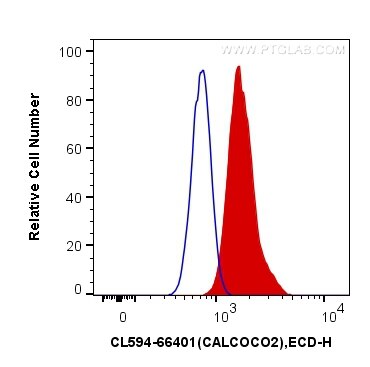Anticorps Monoclonal anti-NDP52
NDP52 Monoclonal Antibody for FC (Intra)
Hôte / Isotype
Mouse / IgG2a
Réactivité testée
Humain
Applications
FC (Intra)
Conjugaison
CoraLite®594 Fluorescent Dye
CloneNo.
2F2C2
N° de cat : CL594-66401
Synonymes
Galerie de données de validation
Applications testées
| Résultats positifs en cytométrie | cellules Jurkat |
Dilution recommandée
| Application | Dilution |
|---|---|
| Flow Cytometry (FC) | FC : 0.40 ug per 10^6 cells in a 100 µl suspension |
| It is recommended that this reagent should be titrated in each testing system to obtain optimal results. | |
| Sample-dependent, check data in validation data gallery | |
Informations sur le produit
CL594-66401 cible NDP52 dans les applications de FC (Intra) et montre une réactivité avec des échantillons Humain
| Réactivité | Humain |
| Hôte / Isotype | Mouse / IgG2a |
| Clonalité | Monoclonal |
| Type | Anticorps |
| Immunogène | NDP52 Protéine recombinante Ag2866 |
| Nom complet | calcium binding and coiled-coil domain 2 |
| Masse moléculaire calculée | 446 aa, 52 kDa |
| Poids moléculaire observé | 52 kDa |
| Numéro d’acquisition GenBank | BC015893 |
| Symbole du gène | CALCOCO2 |
| Identification du gène (NCBI) | 10241 |
| Conjugaison | CoraLite®594 Fluorescent Dye |
| Excitation/Emission maxima wavelengths | 588 nm / 604 nm |
| Forme | Liquide |
| Méthode de purification | Purification par protéine A |
| Tampon de stockage | PBS avec glycérol à 50 %, Proclin300 à 0,05 % et BSA à 0,5 %, pH 7,3. |
| Conditions de stockage | Stocker à -20 °C. Éviter toute exposition à la lumière. L'aliquotage n'est pas nécessaire pour le stockage à -20oC Les 20ul contiennent 0,1% de BSA. |
Informations générales
NDP52, also named as CALCOCO2, is an autophagy receptor. It plays a role in ruffle formation and actin cytoskeleton organization. Mouse/Rat NDP52 has some isoforms with MW 28-40 kDa and 67 kDa. Human NDP52 has some isoforms with MW 43-47 kDa and 52-55 kDa,
Protocole
| Product Specific Protocols | |
|---|---|
| FC protocol for CL594 NDP52 antibody CL594-66401 | Download protocol |
| Standard Protocols | |
|---|---|
| Click here to view our Standard Protocols |



